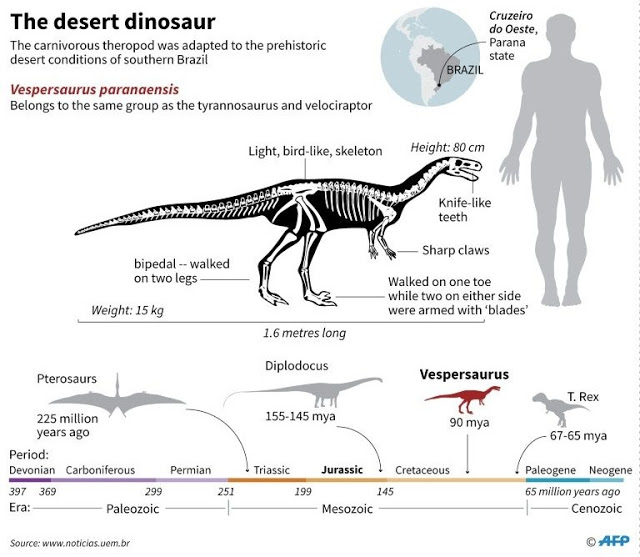A cave in Crimea has yielded the bones of an ostrich like bird – but three times the size of the modern version. At https://archaeologynewsnetwork.blogspot.com/2019/06/bird-three-times-lar… … Humans are said to have lived alongside them but a bison bone in the cave has been dated at one and half million years old (so we are talking about way before the Neanderthals). These giant birds could have been a source of meat, feathers for decoration, bones used for tools, and eggshell (because it is big and oval and can be decorative). The bones of giant cheetahs, giant hyenas, and sabre toothed cats were also found in the same cave deposit, presumably flushed in at some time.
At https://archaeologynewsnetwork.blogspot.com/2019/06/desert-dwelling-carn… … dinosaurs just 5 feet tall have been found in Brazil – yet they were meat eating carnivores. The Vespersaurus (a theropod) were two footed and related to the velociraptor. The region in Brazil is known to have formerly been a desert and the Vespersaurus were adapted to such conditions – it is thought …
 …
…
Meanwhile, at http://blog.drwile.com/soft-tissue-showdown/ … Dr Wile is back again on his theme of soft tissue survival in dinosaurs – and how it is said to contradict the idea they are as old as alleged by paleontologists working within the uniformitarian model. It claims there is no plausible mechanism by which soft tissue can stay as soft for so long a period of time. This used to be the view of a substantial number of paleontologists but all the recent discoveries of soft tissue from dinosaurs has blown the consensus apart. Dr Wile says that paleontologists are now divided into two camps. The first one accepts the soft tissue is from dinosaurs and are seeking a means by which it could stay soft over millions of years. The second group argue that the soft tissue cannot originate from the dinosaurs but must come from creatures (such as bacteria) involved in the fossilisation process. A new study actually claims partial support for the latter. Organic remains from a recent excavation of a Centrosaurus turned out to be bacterial in origin rather than collagen from bones. Dr Wile goes on to describe tests done and C14 dating methodology that turned out to be much younger than the dinosaur is thought to have lived. It was decided the bones had been contaminated somehow but Dr Wile lives in hope that actual soft tissue from a dinosaur will get the same treatment in a lab.
